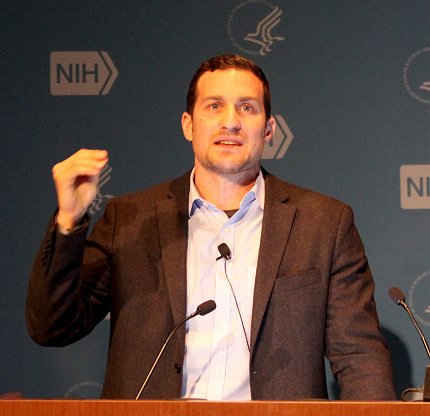'Audacious Goals'
NEI Lecture Features Stanford’s Huberman

Figuring out how to get neurons to regenerate and re-integrate in the brain is one of the biggest unsolved challenges in neuroscience, said Dr. Andrew Huberman, professor of neurobiology at Stanford School of Medicine. NEI featured Huberman at a recent Audacious Goals Initiative seminar in neuroregeneration. His success in regrowing retinal ganglion cells—neurons that carry visual signals from the eye to the brain—suggests neural activity is key.
During development, retinal ganglion cells extend their long telephone wire-like axons from the retina in the back of the eye to visual centers all over the brain. Diseases such as glaucoma initially damage axons at the optic nerve, where the axons leave the eye, eventually causing cell death and potentially vision loss.
To see if he could recapitulate the developmental process in adult mice, Huberman injured the optic nerve from one eye and then tested a variety of known axonal guidance factors, including mammalian target of rapamycin (mTOR). He saw modest regrowth of axons with mTOR, but more robust growth when he combined it with exposure to high-contrast visual stimulation, achieved by placing the mice in a chamber displaying changing patterns of black lines for several hours each day. Growth was further enhanced by forcing the animal to use the injured eye.
“Regenerating retinal ganglion cell axons not only regrew from the site of injury, they preferentially re-innervated correct visual targets in the brain,” said Huberman. Three weeks after optic nerve crush, mice that received combination therapy experienced axonal growth at a rate 500 times greater than untreated animals.
Huberman cautioned that the treatment restored only a small fraction of axons. “It’s very few axons—probably less than a hundred—that reach the brain.” Nonetheless, mice regained some visual function, suggesting the approach holds promise for treating disease and injury in people.
For more information about the AGI, including information about upcoming seminars, visit www.nei.nih.gov/audacious.
